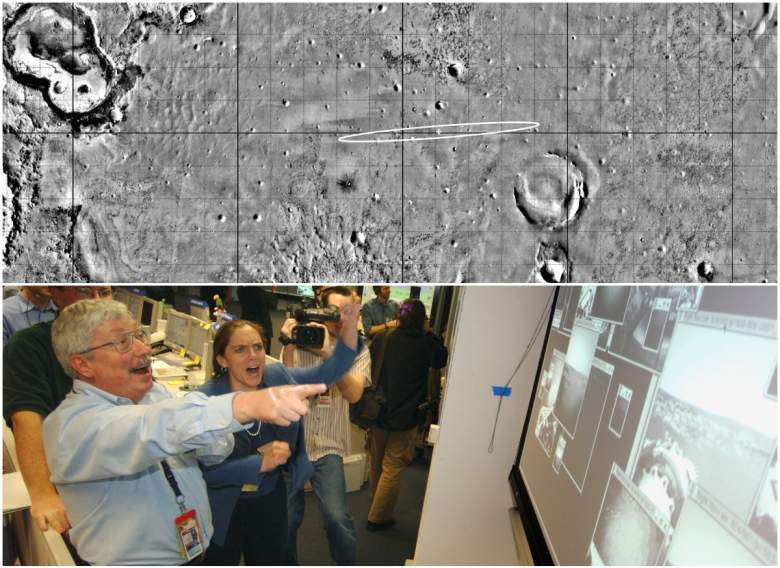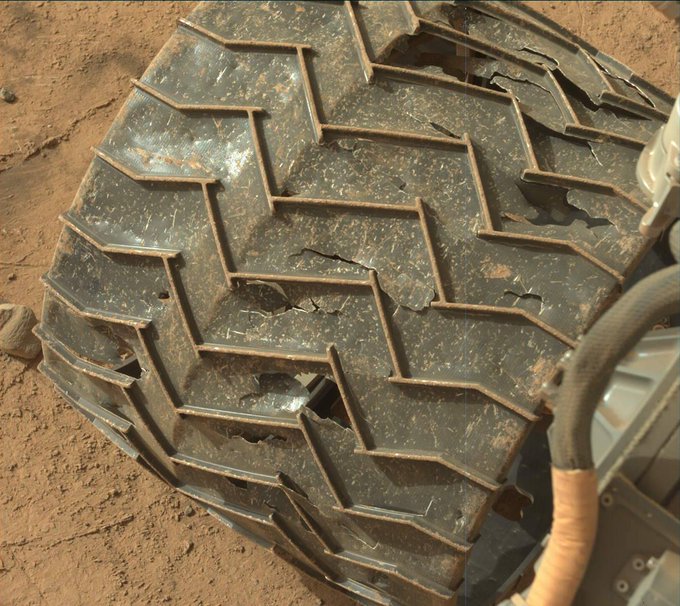
Getty Seen is this handout photo provided by NASA is a satellite image of the hopeful landing area for the Mars Opportunity Rover which is supposed to land January 24, 2004 on the Martian surface. /In this handout photo, Pete Theisinger, project manager (L) and Jennifer Trosper, Spirit Mission Manager for Surface Operations, react as the first images arrive from the NASA Mars Rover, "Opportunity," at Jet Propulsion Laboratory (JPL) on January 25, 2004 in Pasadena, California.
Three years ago today, the death of the Mars Opportunity Rover was announced. The Mars Rover was immortalized, in part, by its “last words.”
NASA released a statement February 13, 2019, with a simple headline: “Opportunity’s Mission Is Complete.”
“No response has been received from Opportunity since Sol 5111 (June 10, 2018), amid a planet-encircling dust storm on Mars. With the last uplink transmission on Sol 5352 (Feb. 12, 2019), the rover recovery efforts are concluded,” NASA wrote. “The Opportunity mission is complete.”
The rover lasted 50 times longer than planned, National Geographic reported, and “made Mars a familiar place” with its twin rover, Sprit, Opportunity project manager John Callas told Space.com.
Follow the Heavy on Houston Facebook page for the latest Houston news and more.
Here’s what you need to know:
Opportunity Launched July 7, 2003 & Was the Second Rover on Mars
Opportunity was sent to Mars to search the planet for water and other signs of life, NASA reported. The rover was the second sent to Mars.
It was launched July 7, 2003, on Mission MER-B: Opportunity aboard a Delta II spacecraft, according to NASA’s launch schedule. Opportunity was launched less than one month after the first Mars Rover, Spirit.
NASA officials held a press conference about Opportunity’s findings and the conclusion of the program on the day of the announcement February 13, 2019.
“The briefing followed NASA’s last planned attempts to communicate with Opportunity late Tuesday evening,” a discussion of the press conference said. “The solar-powered rover last communicated with Earth June 10, 2018, as a planet-wide dust storm was blanketing the Red Planet.”
The dust storm was the backstory to the rover’s “last words,” which were not words at all, of course, but a transmission poetically paraphrased in a viral tweet from science reporter Jacob Margolis.
“She was bouncing along, doing well, until a massive dust storm engulfed all of Mars in June 2018, knocking out communications with the team on earth. They haven’t heard from her since. It’s unclear exactly what happened,” Margolis wrote. “The last message they received was basically, ‘My battery is low and it’s getting dark.’ They hoped that the windy season would clear dust off the solar panels (if that was the problem). Since then they’ve been pinging her again and again, every way they knew.”
Soon, the rover’s “last words” were popping up on T-shirts and memes. Margolis wrote about the tweet for The LAist in an article, “How A Tweet About The Mars Rover Dying Blew Up On The Internet And Made People Cry.”
While the transmission was not as poetic as it appeared in memes, Opportunity’s legacy is legendary. Callas told Space.com that Opportunity expanded mankind’s definition of “the world.”
“When we say, ‘our world,’ we’re no longer just talking about the Earth,” he said. “We have to include parts of Mars as well.”
NASA Recently Announced Its Mars Curiosity Rover Measured an ‘Intriguing Carbon Signature’
Mars exploration certainly did not die with Opportunity. Today, the Mars Curiosity Rover is sending signals back to Earth from Mars. Most recently, NASA announced that the rover had measured a carbon signature that NASA called “intriguing.” Powdered rock samples collected by Curiosity found a type of carbon associated with biological processes, NASA announced January 17, 2022.
“We’re finding things on Mars that are tantalizingly interesting, but we would really need more evidence to say we’ve identified life,” Paul Mahaffy told NASA .”So we’re looking at what else could have caused the carbon signature we’re seeing, if not life.”
Mahaffy was principal investigator of the Sample Analysis at Mars (SAM) chemistry lab before his retirement from NASA’s Goddard Space Flight Center in Greenbelt, Maryland, in December, NASA reported.
Christopher House, a Curiosity scientist who led the carbon study, explained in the article that a carbon signal on Mars could mean something very different from what it means on Earth.
“On Earth, processes that would produce the carbon signal we’re detecting on Mars are biological,” House told NASA. “We have to understand whether the same explanation works for Mars, or if there are other explanations, because Mars is very different.”
And the Mars Curiosity Rover is taking Twitter into its own hands. It has its own Twitter account, which posts frequent updates and photos from Mars.
READ NEXT: Aaron Christopher Kelly, Richland Fred Meyer Shooting Suspect: 5 Fast Facts You Need to Know


Comments
Today in Houston History: Mars Opportunity Rover Dies Feb. 13, 2019